A charming village in northeastern Spain
Friday, June 30, 2017
The last weekend, I listened a radio program, in which they talked about one of the most beautiful villages in Spain: Albarracín; and, then, I wanted to talk to you about it. This village, placed in the province of Teruel (Aragon), it has 1054 inhabitants. And, since 1961, it is National Monument.It is also proposed, by Unesco, to be declared a “World Heritage Site” for the beauty and importance of its historical heritage.
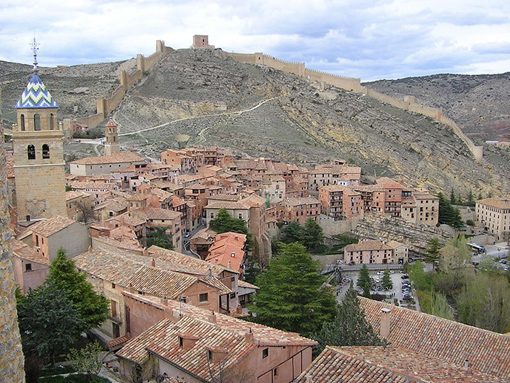
Albarracín and its wall
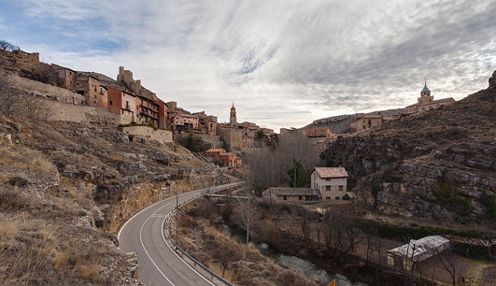
Albarraín from the road –the road A512 from Teruel—
It is located near the ancient Roman city of Lobetum. The Arabs called the place “Alcartam” that would derive of the old place-name of Ercávida, happening to be denominated later like Aben Razin, name of a Berber family, from where would derive its present name. Other people think that the term "Albarracín" would derive from the Celtic alb, 'mountain', and ragin, 'vine', 'grape' or the anthroponym Razin.
Without a doubt, the toponym comes from Ibn (ben) son of Razin (kings taifas from Albarracín from Fitna to Ibn Mardanis, king Lobo from Murcia, ie the place of the Razin´s children, although, until the 19th century, its official name Is City of Santa Maria de Albarracín, being denominated Santa Maria de Oriente, in Islamic time.
The old town is built on the slopes of a mountain, almost entirely surrounded by the river Guadalaviar. To the north, is the Sierra of Albarracín, and, to the south, the mountains Universal. Part of its municipal term is occupied by the protected landscape of the Pinares de Rodeno.
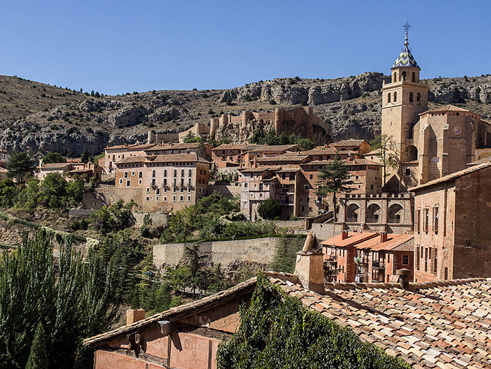
Albarracin from the Main Square
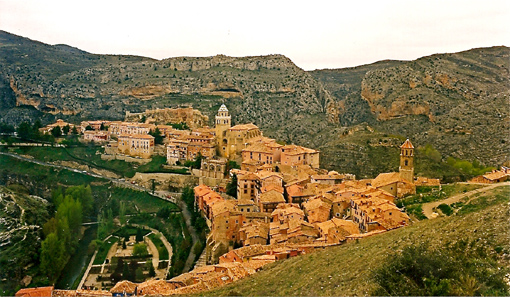
Albarracin and its Sierra
In the surroundings, the Guadalaviar, Tajo, Júcar, Cabriel and Jiloca rivers are born.
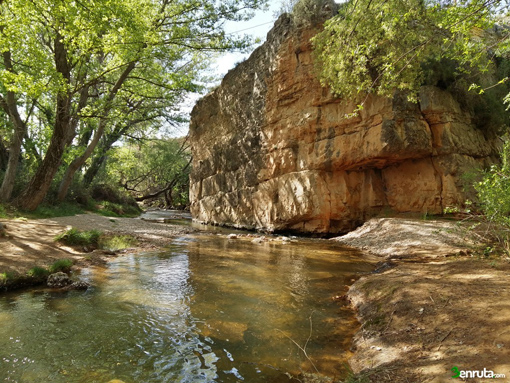
The river Guadalaviar
Its municipal term is, for historical reasons, one of the biggest of the province of Teruel --only surpassed by Alcañiz--.
The village is perched on a rock and surrounded by the Guadalaviar. On this side and facing the river, are built houses hung. Within the village, its streets are steep and narrow, with very picturesque corners. The construction offers the original popular architecture with the own forge of the province, besides having the characteristic reddish color, called Rodeno.
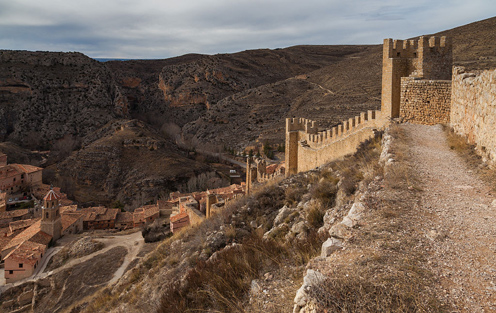
Albarracin from its wall, built in the XIV century
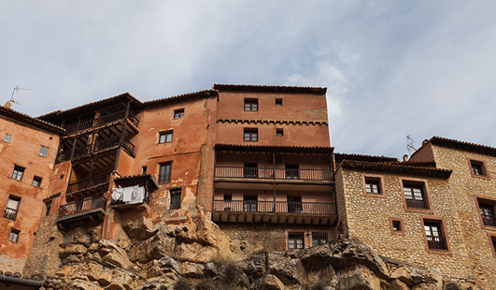
Some hung houses
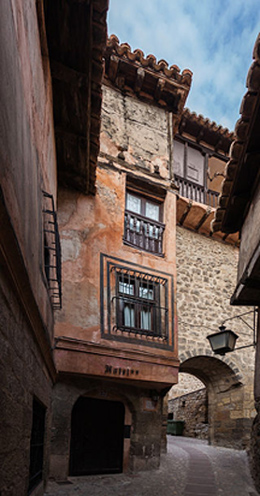
A narrow street
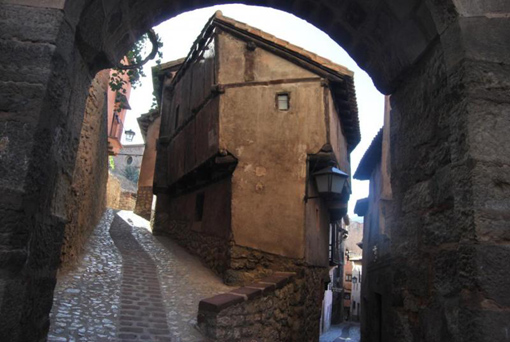
The famous house Julianeta
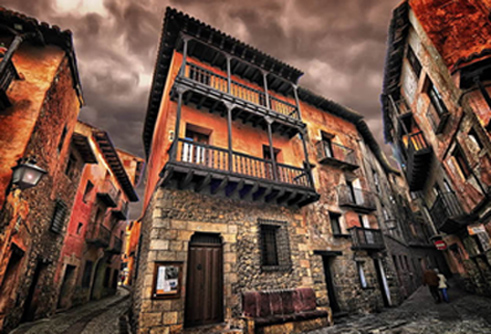
Typical houses in the centre
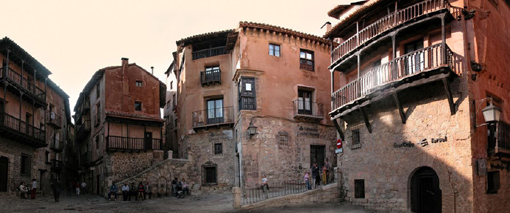
A nice corner in the centre
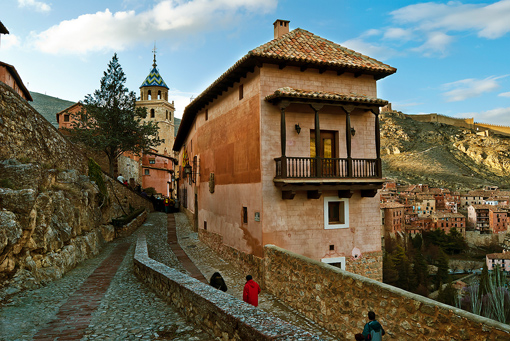
Another nice corner in the village
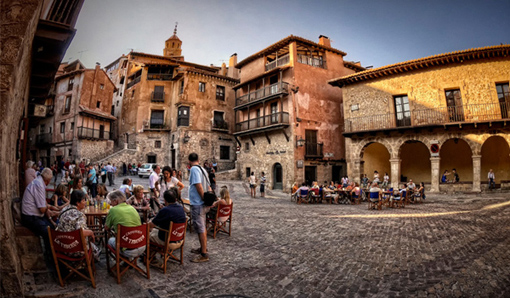
Another small square
In the Iron Age, Albarracín was inhabited by the Celtic tribe of the Lobotans. Important epipalaeolithic and Neolithic cave paintings of Levantine, schematic and semischemátic style have been found, in the pine of the rodeno. During the Roman period, was called Lobetum and, in times of the Visigoths, Santa Maria de Oriente.
During the Andalusian period, specifically the eleventh century, the Berber clan of the Banu Razin came to power becoming the sovereign dynasty of the taifa of Albarracín. From this lineage, it comes the own name of the village (al-Banu Razin: (the city) of the sons of Razin). From this magnificent stage, two important testimonies are preserved: the Andador tower, located at the top of the outer enclosure, and the Albarracín Castle, which housed the ancient citadel of the Banu Razin.
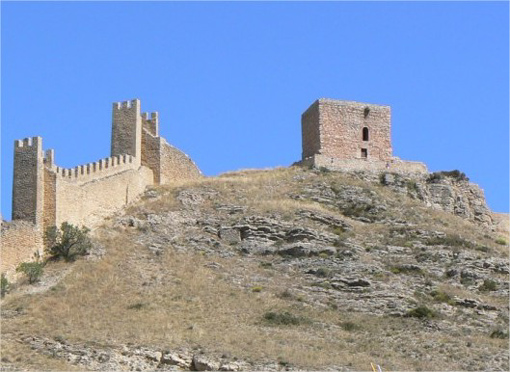
Tower of the Andador
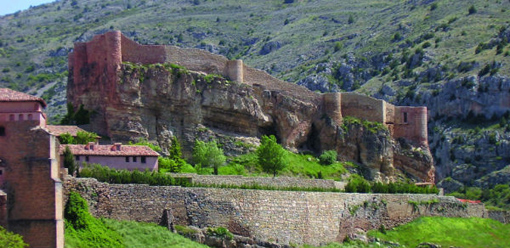
Castle of Albarracin
The Taifa later passed, by assignment and not by conquest, to the Christian family of Navarrese lineage of the Azagra, who maintained de facto the independence of Castile and Aragon from 1170, reaching to create an own bishopric. Also the powerful lineage of Lara exerted its sovereignty on Albarracín. After the failure of conquest, by Jaime I in 1220, it is Pedro III of Aragon who conquered it, in 1285, after besieging it, passing definitively to the Crown of Aragon, in 1300. This series of political facts was based on the importance of the strength and of the defensive system of Albarracín.
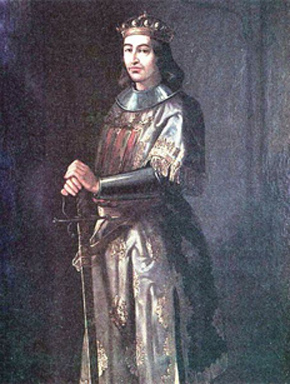
Pedro III of Aragon
It is an old episcopal seat denominated, first Arcabricense and later Segobricense, until, after the dismemberment of the churches of Segorbe (Castellón) of the churches of Albarracín, it happened to denominate Albarracinense, after Papal Bull of John Paul II, maintains its independence but it happens to be governed by the Bishop of Teruel, who is also Bishop of Albarracín.
On June 21, 1257, the King Jaime I granted, in Teruel, to the Community of Santa María de Albarracín or Community of villages of Albarracín, the privilege on jurisdiction of sexmeros*, assistants and jurors of that city. The *sexmero was responsible for the business and rights of a "sexmo"; a sexmo was a medieval Castilian administrative division, which generally comprised a part of the rural term, dependent on a city. The sexmos were equivalent to the sixth part of a determined territory.
During the Spanish Civil War, fights took place, in the locality, between the republican troops and the Francoists, changing several times the control of the population between both sides. In July of 1937, a republican offensive took place on the locality, constituting the greater confrontation warlike had been, in the locality, during the war. In a quick attack, on July 8 Republicans took control of the village, except for the Czouncil and the Cathedral, where they remained besieged military and civilians, who had previously sought refuge. The rebels responded by sending reinforcements and on July 13 managed to reconquer the locality and expel the Republican troops.
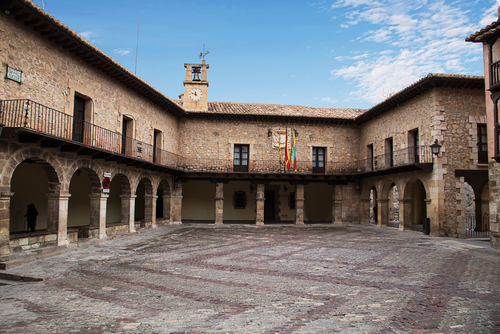
The square of the Council
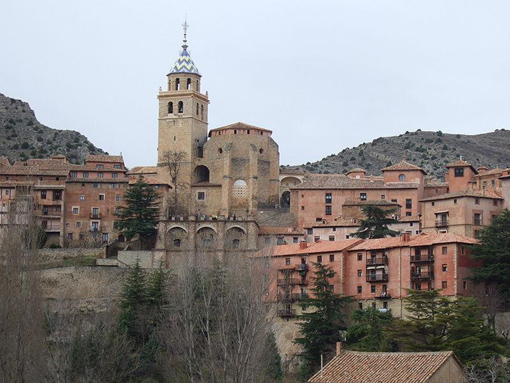
General view of the Cathedral
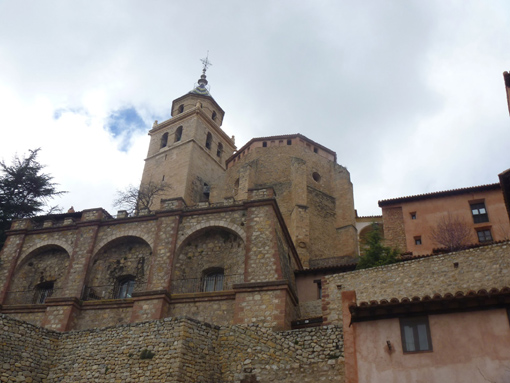
The Cathedral
Well, I hope that you have liked this article and hope that you can wish and can visit this nice village.
Until my next post, kind regards,
Luis.
Sponsored by Costaluz Lawyers.
Please click below:

 1
Like
Published at 1:58 AM Comments (0)
1
Like
Published at 1:58 AM Comments (0)
Another spanish saying and proverb 73
Tuesday, June 27, 2017
Today, I would like to talk to you about a very popular expression in Spain: “¡Apaga y vámonos!” = "Turn it off and let's go!".
It is said that this phrase was born of the argument, raised among two clerics, aspirants to the same chaplaincy, about which of them could say the Mass in less time.
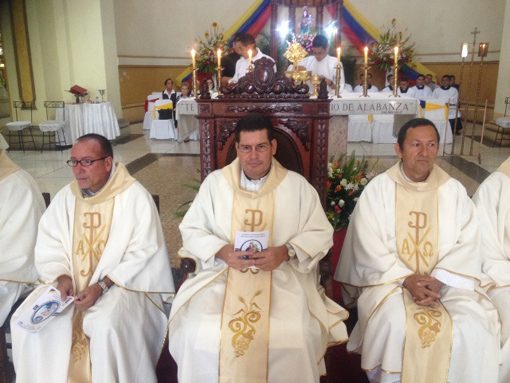
And, as they put themselves to it, one would come to say, without further ado, the final rubric formula: "ite, misa est", the other one, without thinking about it, turned to his altar boy and finished: "Turn off and let's go!".

Since then, that phrase has become an expression of the absurd and ludicrous or, alternatively, a sign of radical discouragement. For example: "I saw him so out of his mind, that I said: Turn off and let us go".But other times, it is used to say for example: "If he has clear his decision, turn off and let us go".
Well, I hope that you have liked this saying.
Until my next post, kind regards,
Luis.
Sponsored by Costaluz Lawyers.
Please click below:

 0
Like
Published at 2:42 PM Comments (0)
0
Like
Published at 2:42 PM Comments (0)
Spanish scientists get a discovery related to the human ear
Monday, June 26, 2017
The sense of hearing is very important, in our body, and today I would like to share with you this news so full of hope: "Spanish and French scientists have identified the cells that set in motion the development of the nervous system of the inner ear”.The Spanish scientists are from the Pompeu Fabra University (UPF) and the french scientists are from the Toulouse University.
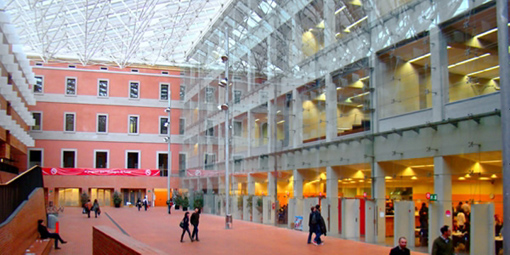
The Pompeu Fabra University (Barcelona)
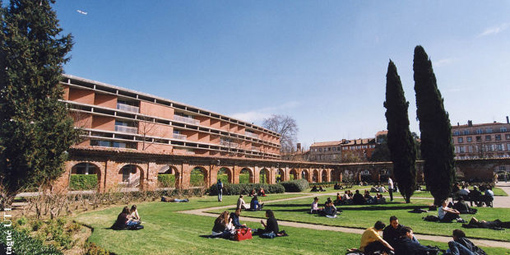
The Toulouse University
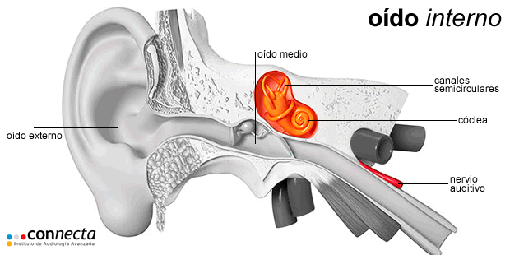
The inner ear
The finding, published by the “eLife” magazine, shows that the pioneer neurons are outside the inner ear and, once activated, they migrate to this tissue, to induce the formation of more neurons, in the inner ear.
The inner ear is the organ responsible for the senses of hearing and balance, and it is formed by a series of cavities, filled with fluid. The sounds and movements of the head cause the fluid inside the cavities to move and activate the sensory neurons, which send the information to the brain, so that if these cells are damaged, they can cause diseases like deafness or vertigo.
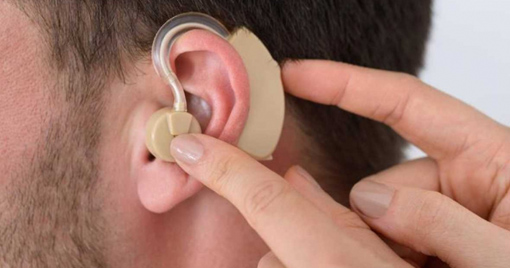
Deafness
Until now, scientists believed that all neurons, in the inner ear, were developed within an area of the embryo, known as inner ear epithelium and that the cells, in this region, would activate the neurog1 gene, which would trigger a series of changes, that would turn them into neurons of the inner ear.
However, thanks to the use of new microscopy techniques in zebrafish embryos, the team led by Berta Alsina, a researcher who heads the Morphogenesis and Signaling Systems Laboratory of the UPF, has discovered that this process begins earlier, with the arrival of external cells to the epithelium.
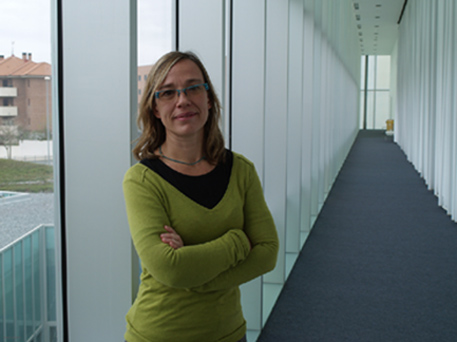
Berta Alsina
Despite not having external ears, the zebra fish have, inside the cranium, an inner ear that gives them the sense of balance and hearing, and it is very similar to the ear of humans. In addition, zebrafish embryos are transparent, making it possible to directly visualize the activation of genes and cell motions.
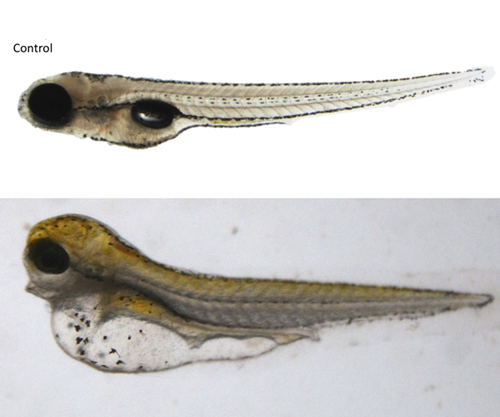
Zebrafish embryos
Using images of zebrafish embryos, in real time --what the scientific community calls “4D imaging”--, the scientists show that the first cells, that activate the neurog1 gene, do it outside the inner ear and then migrate to the inner ear epithelium and cause activation of neurog1 to the new neighboring cells.
"A substance called Fibroblast Growth Factor (FGF) is responsible for telling the inner ear epithelium to let pioneer neurons enter, thus controlling the final number of neurons, in the inner ear", said Alsina's laboratory researcher, Esteban Hoijman.
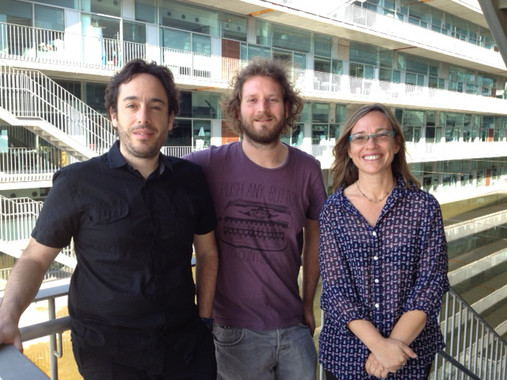
On the left side: Esteban Hoijman. On the right side: Berta Alsina.
"We have identified a new group of cells, that act as pioneers of the neurogenesis of the ear", said Hoijman, who has detailed that "these cells have two essential functions: they constitute the first specialised cells of the epithelium and promote the specialization of cells, resident in the inner ear ".
The work, led by Alsina, reveals how the coordinated activation of genes and the movement of cells give rise to neurons of the inner ear, which provides an insight into the mechanisms, that form other types of sensory tissue, such as the visual or the olfactory. According to Alsina, this discovery may be useful for designing new therapies related to neuropathies, such as deafness.
Well, I hope that you have liked this news, such as I have.
Until my next post, kind regards,
Luis.
Sponsored by Costaluz Lawyers.
Please click below:

 0
Like
Published at 10:30 AM Comments (0)
0
Like
Published at 10:30 AM Comments (0)
A simple recipe by a great Spanish chef
Thursday, June 22, 2017
Today I would like to show you a recipe prepared by the great Spanish chef, Karlos Arguiñano: "Leek and prawn cake".
These are the Ingredients (for 6 persons): 4 leeks. 250 grams of prawns. 7 eggs. 400 millilitres of liquid cream. 1 seed bread. Butter and flour (for the mold). Extra virgin olive oil. Salt. Pepper. Nutmeg. Parsley.
And this is what you have to do: Cut the bread into thin slices, spread them on the oven tray and toast them, until golden.
Now wash the leeks, finely chop them and place them in a frying pan with olive oil. Leeks must be well poached, until they are soft. Peel the prawns, cut them into small pieces, pour salt and pepper and add them to the leek pan. Remove everything and move the pan away from the stove burner.
Spread an elongated mould with melted butter, place a strip of baking paper along it so that it protrudes, spread the butter and sprinkle it with flour. Add leeks and prawns.
Beat eggs in a bowl, salt and pepper, add the cream, grate over a little nutmeg and mix everything well. Pour the mixture into the mould and bake, to the water bath, at 180 degrees, for 45 minutes. Let it quench, demold and cut the cake into portions.
Then, sauté the heads and the shells of the prawns, in a saucepan, with a trickle of oil. Scrape them and wring them in a strainer.
Serve the cake, with the slices of toast and the prawn juice. Garnish with parsley leaves.
And this must be the result:
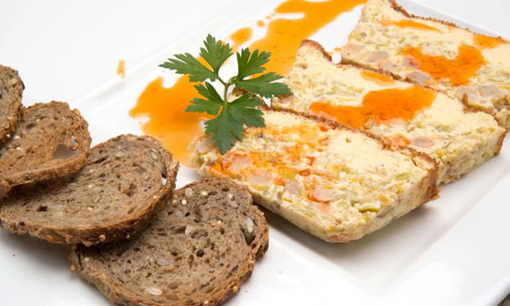
Well, I hope that you want to try to cook this recipe and hope that you like it. Please tell about it.
Until my next post, kid regards,
Luis.
Sponsored by Costaluz Lawyers.
Please click below:

 0
Like
Published at 7:08 PM Comments (0)
0
Like
Published at 7:08 PM Comments (0)
Spanish scientists participate in an important discovery against Cancer
Tuesday, June 20, 2017
Some days ago I found a very interesting news that said: “Liver stem cells are involved in the development of tumors”.
Malignant transformation of hepatocytes is the origin of most hepatocarcinomas, an aggressive liver tumor with high mortality rates. But these cells do not act alone. A study by scientists, at the National Cancer Research Center (CNIO), shows how hepatocytes "recruit" and "instruct" stem cells or liver progenitors, that contribute to the progression of lesions.
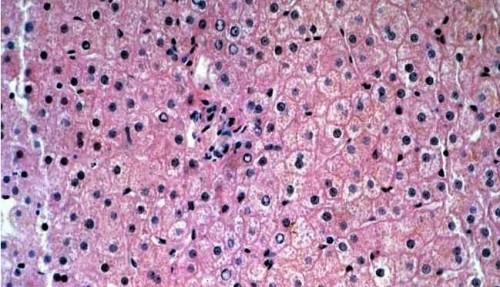
Hepatocytes
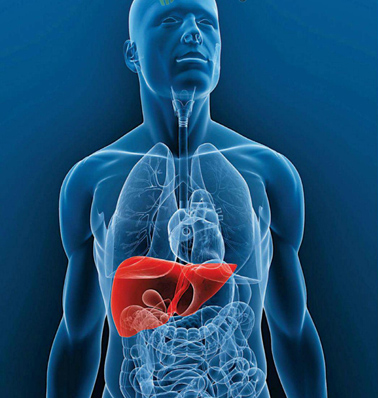
Liver with stem cells
"Cells, that cause liver cancer, as well as the beginning of their heterogeneity, are not yet clear and may depend on context", the authors write in the “Cell Reports” pages. Until now, hepatocytes --majority liver cells-- have been considered the main beginning of hepatocarcinomas, but the results of this research provide several nuances.
"What we show here is that the progenitor cells expand themselves, during the development of the tumors and, at a given moment, they are transformed due to the interaction with the oncogenic hepatocytes, which recruit them to participate in this process", explains Nabil Djouder, head of the Group of Growth Factors, Nutrients and Cancer of the CNIO and main author of the research.
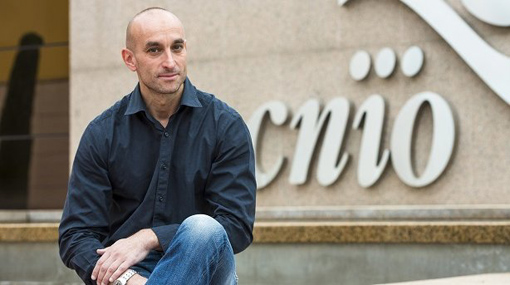
Nabil Djouder at the CNIO
Thanks to an animal model --created by Djouder and his team--, which too accurately reproduces the process of tumor formation, in the human liver, and to various genetic experiments, the authors have tried to define the histopathology of the different tumors, that are developed in this organ, both benign (regenerative nodules, adenomas) and malignant (hepatocarcinoma or HCC).
"This is what we have observed: oncogenic hepatocytes give rise to hepatocellular carcinoma but, in this model that simulates human hepatocarcinogenesis, progenitor cells also participate. They do this mainly by causing benign tumors but, sometimes, aggressive carcinomas", says Djouder. That is, progenitor cells become oncogenic, even though in the early stages of tumor development they have not been transformed.
Malignant hepatocytes interact and instruct neighboring progenitor cells, to activate and maintain them, in an undifferentiated state, while they proliferate and expand themselves, which makes them oncogenic and contributes to the progression of lesions. This activation occurs, as this work shows, when hepatocytes secrete two molecules (alpha-ketoglutarate and galectin-3), that transform the progenitor cells.
"By blocking galectin-3, we were able to inhibit the interaction between these cells and we observed a reduction in tumor formation, a finding that could have therapeutic implications", says Djouder.
Well, this morning, I have listened on the radio to Mariano Barbacid (the Manager of the CNIO) and he complained talking about the lack of funding in Spanish scientific research. And I agree with him and hope that this lack changes as soon as possible.
Until my next post, kind regards, Luis.
Sponsored by Costaluz Lawyers.
Please click below:

 0
Like
Published at 3:11 PM Comments (0)
0
Like
Published at 3:11 PM Comments (0)
Civica: an abandoned hamlet in Spain
Monday, June 19, 2017
Today I would like to talk to you of a very curious hamlet: Civica.
If you go along the CM-2011 road that connects Masegoso de Tajuña to Brihuega, with a winding road that follows the capricious route of the river Tajuña, you will find Civica, a small abandoned village, with arches, doors and balustrades pierced, in the rock of the mountain, that make it a place with a great patrimonial wealth, in Guadalajara.
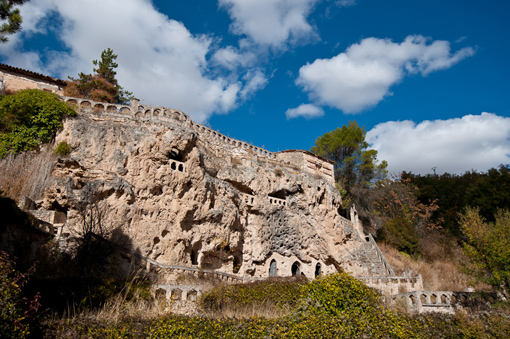
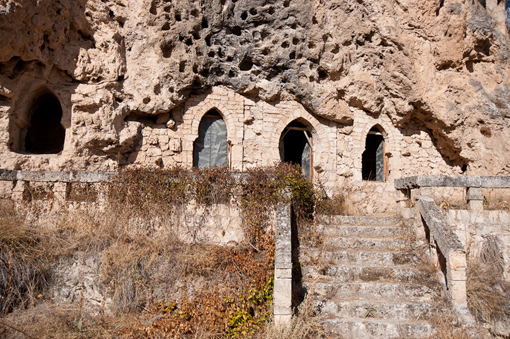
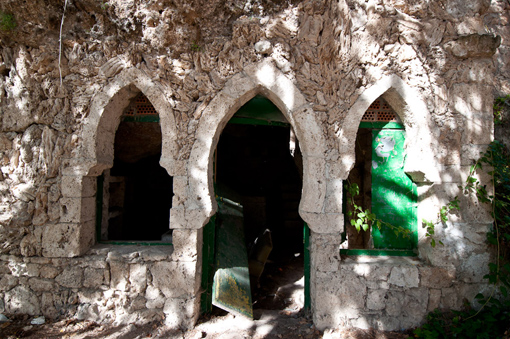
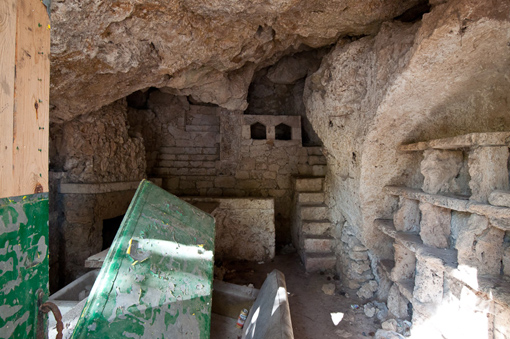
The place shall surprised you a lot, such as almost all the cars that pass through there, which stop to take a look at the remains of Civica, not every day you can look something like this, apparently these abandoned remains of an old hamlet, that now belongs to a nearby worker´s house, the place is open and without any fence or warning.
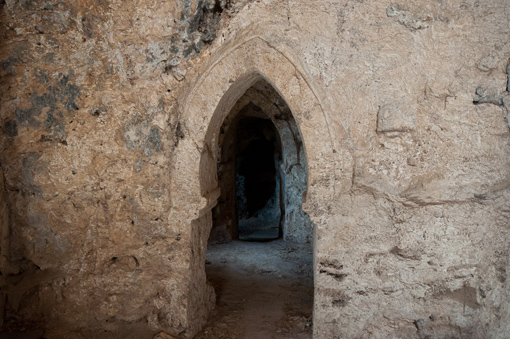
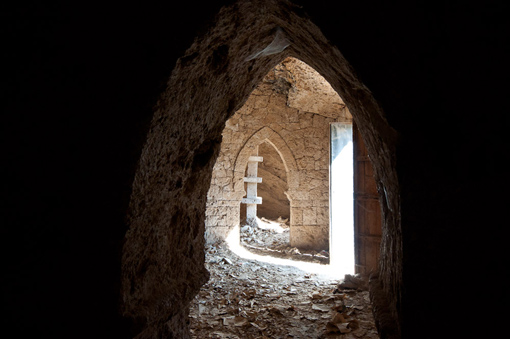
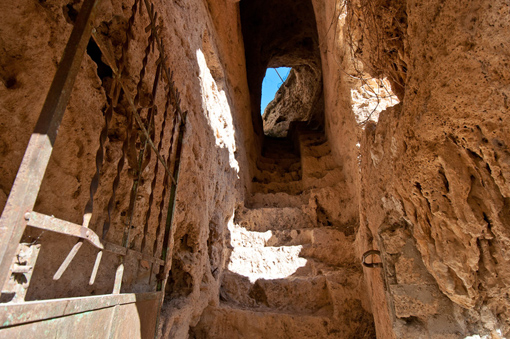
The karstic characteristics of the rock made possible the creation of this structure of tunnels, hollows, windows, thanks to the erosive action of wind and water; the human touch was made by Don Aurelio, the priest of Valderrebollo, who, in the sixties, inherited the worker´s house, where this abandoned hamlet is located and every day, after the mass, that he officiated at Yela, with the help of voluntary parishioners, he dedicated himself to building, on the rocks and hollows, a labyrinth of balustrades, banisters and stairways, that communicated the caves among themselves.
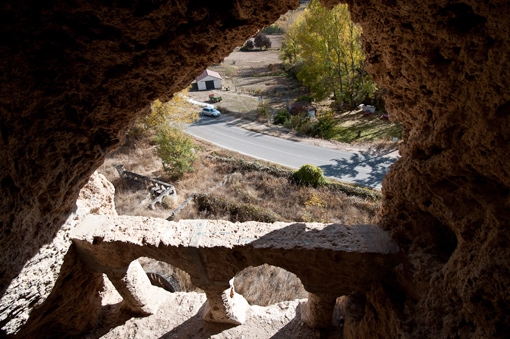
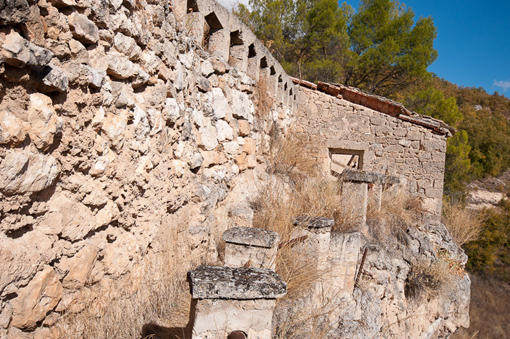
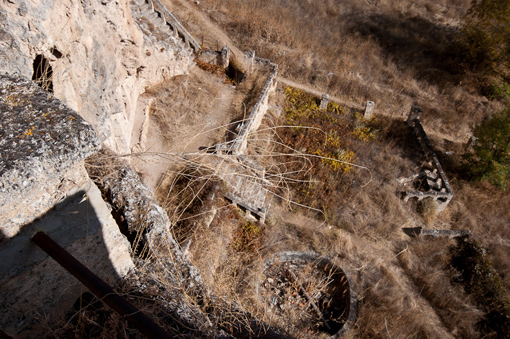
Civica is in a state of total abandonment; some little walls, annexed to the karst rock, were collapsed; vegetation and weeds were growing everywhere and entering the enclosure became somewhat dangerous; you could see what was a kind of fountain and a small square with cobble stone; It seems that, in one of the caves at the bottom, there was a bar that was frequented by fishermen, in the area between Masegoso and Brihuega –and the thing is the river Tajuña is only 500 metres away--, amall bottles, broken mugs and crystals on the ground, covered with dust, betrayed the presence of that bar.
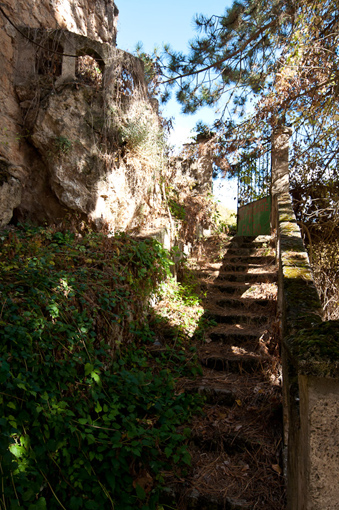 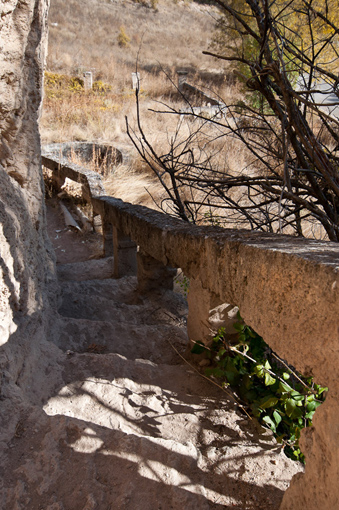
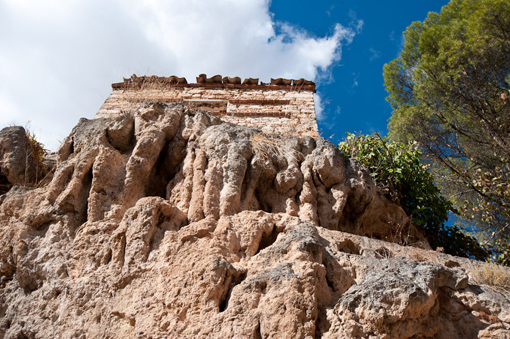
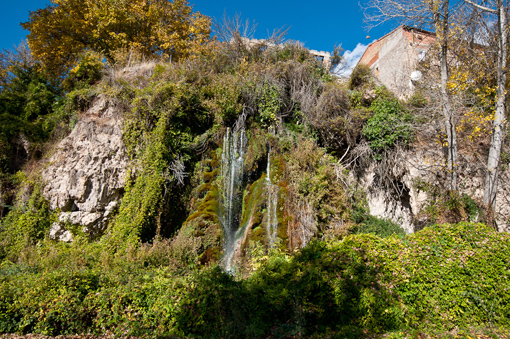
Ruins aside, the place, where the abandoned village of Civica is located, is of great scenic beauty, above all I recommend you going in Autumn, because, in that season, a series of waterfalls run from the mountain, where the tunnels are pierced; as if a garden was, the mountain is invaded by moss and vines, water everywhere and springs flowing to the riverbed of the Tajuna, a few metres below.
A very recommendable place to visit, at least in the vicinity and to delight us with the structures that a priest altruistically built, in his leisure hours.
Well, I hope that you have liked the pictures and hope that you can go to that lovely place. If you do it, please tell me soon.
Until my next post, kind regards,
Luis.
Sponsored by Costaluz Lawyers.
Please click below:

 1
Like
Published at 10:20 AM Comments (0)
1
Like
Published at 10:20 AM Comments (0)
Spanish scientists generate neurons affected by degenerative processes
Wednesday, June 14, 2017
Today, I would like to show you an important news for Medicine: “Scientists manage to generate neurons affected by neurodegenerative processes”.
Effectively, researchers from the Institute of Bioengineering of Catalonia (IBEC) have managed to generate neurons affected by two different neurodegenerative processes, from the skin cells of a patient with a rare neurodegenerative disease, the Gerstmann-Sträussler-Scheinker syndrome.
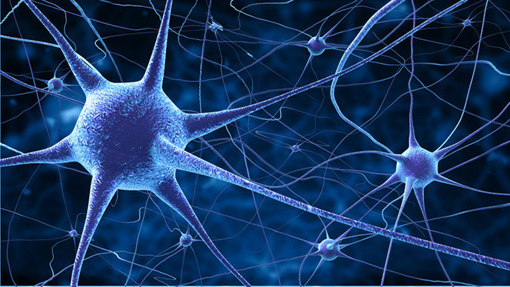
According to the researchers, the ability to develop cellular models with characteristics of two unrelated neurodegenerative diseases, in the same neurons, will help in the study of other neurodegenerative diseases, with a similar diagnosis, such as Alzheimer's.
The study, published in the journal “Molecular Neurobiology”, was a collaboration between IBEC researchers, led by José Antonio del Río, also a professor at the University of Barcelona (UB); Adolfo López de Munain, neurologist of the Hospital of Donostia; and Isidre Ferrer, of the Pathology Department of Bellvitge Hospital, all members of the Center for Biomedical Research in the Network of Neurodegenerative Diseases (CIBERNED).
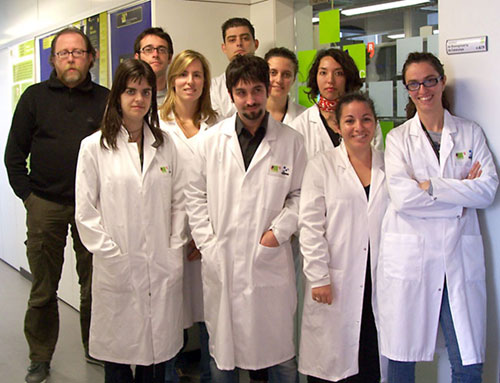
Jose Antonio del Rio, on left side, and his team
The research began when doctors, who analysed the brain of a deceased patient, found that, in addition to tauopathy --a neurodegenerative disorder— it also had a genetic mutation, that causes a much more rare neurodegenerative disease, the Gerstmann-Sträussler-Scheinker syndrome (GSS ), a prionopathy involving a mutation of the PRNP prion protein gene.
According to the IBEC researcher, Andreu Matamoros, finding two neurodegenerative diseases, with a different origin, --a tauopathy and a prionopathy--, in the same patient, aroused the curiosity of the doctors, which led them to contact the IBEC researchers.

A human brain
"This unexpected relationship opens the door to the search for new therapeutic targets that prevent both diseases from complementing each other to provoke degeneration and neuronal death", Matamoros, the study's lead author, has said.
The researchers had the support of a member of the family of the patient, carrying the same mutation, who donated cells from his skin. They reprogramed these somatic cells and converted them into neurons, to study the relationship between tauopathy and the mutation observed in the PRNP gene. "The neurons, generated in this study, are the first cell line induced from fibroblasts of a GSS patient", Jose Antonio Del Rio, research coordinator, has said.
To reprogram the fibroblasts, to generate neurons, they were first reprogrammed into induced pluripotent stem cells, a transition developed by the Angel Raya group of the Center for Regenerative Medicine in Barcelona.
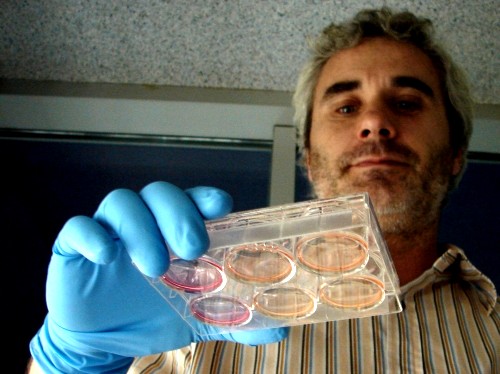
Angel raya in the laboratory
The second step, which consisted in differentiating iPS cells into neurons, was carried out, in parallel, in the groups of Rosario Sánchez-Pernaute (Inbiomed), Joaquín Castilla (CiCBiogune) and José Antonio Del Río (IBEC).
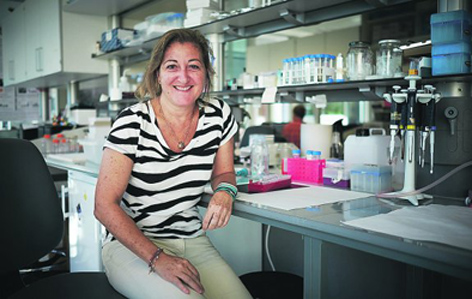
Rosario Sanchez-Pernaute in a laboratory of Imbiomed
"We work in parallel because of the complexity of creating neurons from pluripotent cells. Fortunately, we found that the two proposed methods successfully generate fully functional neurons", Del Río has said.
Well, I hope this news has seemed to you as interesting as to me.
Until my next post, kind regards,
Luis.
Sponsored by Costaluz Lawyers.
Please click below:

 0
Like
Published at 11:42 AM Comments (0)
0
Like
Published at 11:42 AM Comments (0)
Spanish-style beef
Monday, June 12, 2017
Today, I would like to show you a récipe of “Spanish style beef with fried potatoes”.
These are the Ingredients: 1 kilogram of beef. 2 tablespoons of olive oil. Peppers. Rosemary. 2 cloves of garlic. 1 onion. 1 tablespoon of flour. 1 glass of white wine. 1 glass of broth. 1 tin of mushrooms. 2 pear tomatoes. 2 big carrots. 1 tin of peas. Chopped parsley. Potatoes.
How to cook this dish?. Well, you have to follow these steps: Cut the meat into cubes --not very large-- and brown them in hot oil; add salt and pepper on top, and add the peppers in strips, onion and chopped garlic and cook a little more.
Sprinkle with flour and a tsp. of paprika; mix and soak with the white wine; let it boil, for a few minutes, and add the broth.
Now, cover and cook over low heat for half an hour; then add the sliced tomatoes and the mushrooms, the carrots and the peas and cook, for another 15 minutes.
Serve the result with chopped parsley and boiled potatoes.
And this must be the result:

Well, I hope that you have liked this recipe and hope that you want to try to cook it and tell me the result.
Until my next post, kind regards,
Luis.
Sponsored by Costaluz Lawyers.
Please click below:

 0
Like
Published at 9:00 AM Comments (0)
0
Like
Published at 9:00 AM Comments (0)
Another spanish saying and proverb 72
Wednesday, June 7, 2017
Today, I would like to share with you a very popular saying, named: "Antón Pirulero, cada cual atienda su juego" = "Antón Pirulero, each one attends its game".
This saying urges you to deal with your own affairs and not get involved in your neighbor's affairs. And it does this with words borrowed from an old children's game --from when I was a child--, which was cheerfully encouraged by a small song that read:
Anton, Anton, Antón, Antón,
Antón Pirulero, Antón Pirulero,
cada cual each one,
cada cual que atienda a su juego each one who attends its game
y el que no lo atienda, and who does not attend it,
pagara una prenda. will pay a pledge.

The musical group "Cantajuegos" singing and dancing the song "Anton Pirulero"
Well, I hope that you have liked to know this song, in case you did not.
Until my next post, kind regards,
Luis.
Sponsored by Costaluz Lawyers.
Please click below:

 0
Like
Published at 10:49 AM Comments (0)
0
Like
Published at 10:49 AM Comments (0)
A group of Spanish doctors conducted a study on chronic pain
Monday, June 5, 2017
Today I would like to share with you an interesting news: "Chronic pain has a physical and psychological impact similar to that of cancer".
Chronic pain is a "real disease", with a physical and psychological impact similar to that of cancer --according to GPs and family doctors--, who consider it to be a global public health problem and the most frequent cause of suffering and disability.

The responsible of the Pain Working Group of the Spanish Society of General Practitioners and Family Doctors (Semg), Juana Sánchez, maintains this and warns that, despite the international consensus, that patients with chronic pain should be treated, it is estimated that 80% of the world's population, with moderate or severe pain, has "insufficient or lacking" access to treatment.
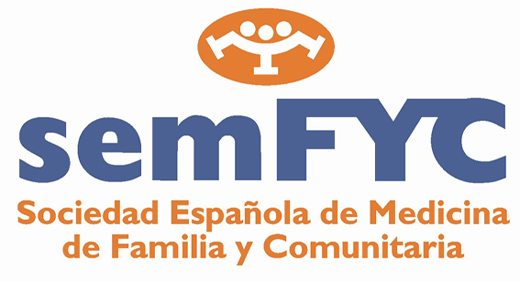
Semg
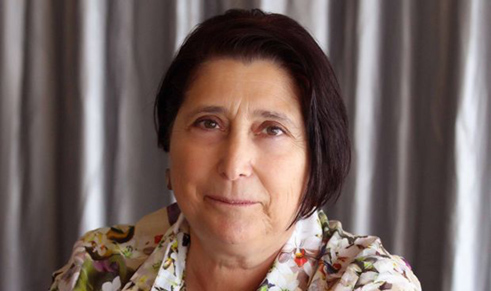
Juana Sánchez
In Europe, the prevalence of chronic pain is estimated at 19%, with important labor and personal repercussions, poor access to specialised treatment resources, 50% with insufficient treatment and one third of patients without treatment, according to the experts of the society (Semg).
In Spain, 6.1 million people suffer from pain, that is, 17% of the population, and women are those who present pain more frequently than men (61% versus 39%) and more intensely.
About the pain and diseases that cause it will be treated by family physicians, at the XXIV National Congress of General and Family Medicine, of the Semg, between 18 to 20 May, in San Sebastian (North of Spain).
Primary Care physicians are the first to diagnose and treat diseases, that cause both acute and chronic pain and this places them, in a key position, to address it.
Well, I hope that you have liked this article.
Until my next post, kind regards,
Luis.
Sponsored by Costaluz Lawyers.
Please click below:

 0
Like
Published at 11:57 AM Comments (0)
0
Like
Published at 11:57 AM Comments (0)
Esconjuradero: a spanish solution against hail
Thursday, June 1, 2017
Perhaps you do not know the word "Esconjuradero", a word that comes from the Aragonese --Aragón is a region of the Northeast of Spain-- : "Esconchurar", that means "to Conjure". Well, the “Esconjuraderos” are an architectonic element characteristic of the Culture and traditions from Pyrenees, with a strong presence in the Aragonese Pyrenees. The Esconjuraderos are small constructions or bandstands, that from the XVI to the XVIII century, were constructed specifically to house rituals, destined to hide or to conjure storms or thundering, hailstorm, the plagues and other dangers, that threatened to the harvests.
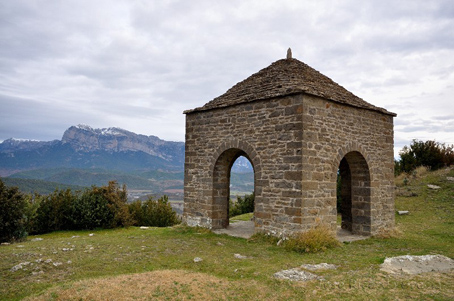
An Escoonjuradero
They are of simple and precise geometry, with sober and cold architecture, very few decorative elements and made with common materials (masonry, rough stone for bays and roofs, stone slab or Arabic tile). The walls can accommodate bays of different sizes, usually a half-point arch. The floor is unified with slabs of stone, brick or river stones, while the roof is made by a vault of cloister, a semi-spherical vault or false dome.
They represent an important proof and witness of the Pyrenean culture. The mountain society attended the aspects of climatology, with the same superstition and practices as in other aspects of everyday life. The Esconjuraderos constituted an important space, from which the priest and the population invoked to deflect or to undo the storms or thunders, that could spoil the fields and harvests. This is why these buildings are located at points, where there is a wide view of the horizon.
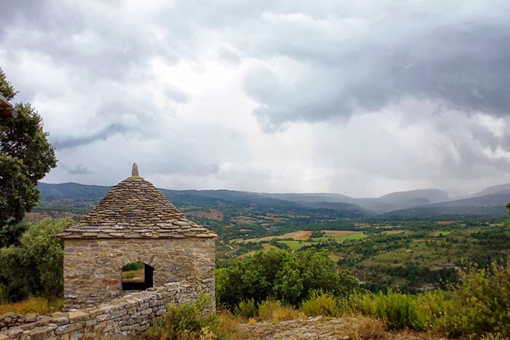
An Esconjuradero with a wide view of the horizon
Rituals, intended to ward (esconjurar) off storms and plagues, are classified within the beliefs and practices of a society, that firmly believed that magical-religious rituals; were the only weapon, that they had in order to control the devastating effect of nature on their lives. A rural society, with great difficulty in cultivation (water scarcity or land shortage, abrupt orography, technical difficulties, etc.) was highly sensitive, to cyclical natural phenomena, such as droughts, summer hailstorms or storms.
That is why it is not uncommon to observe that, in the traditional daily life of the Pyrenees, there existed a great number of rituals, related to the protection of houses, people, fields, animals ... --such as scarecrows in “Chamineras”, ie “traditional chimneys”-- or thistles and feet of animals, on the doors of houses).
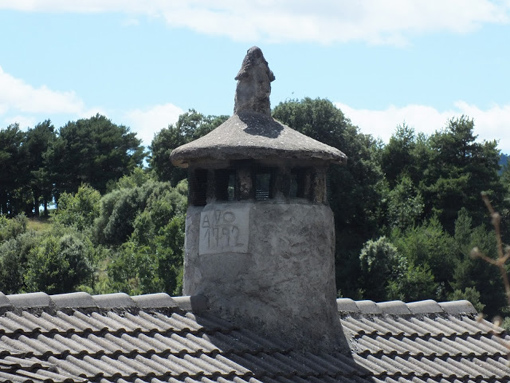
A "Chaminera" with scarewitch. You can read: Year 1792
Like so many other traditions of pagan origin, this attempt to control the nature, that the human being made from ancestral times, was Christianized by the Church, becoming part of the Catholic liturgy. In this context, the rituals to hide are classified. According to some authors, since the beginning of the sixteenth century, spells, made in the porticos, windows or church steeples, are documented. The references to these rituals dot the province of Huesca and it does not seem strange that different shrines, specifically designed for that purpose, were created.
While the priority mission of these rituals was probably to ward off storms or thunderstorms and to protect the fields from the devastating effects of lightning and hailstones, their mission is also documented as a repeller of pests and damaging animals. In addition, in the Middle Ages, there was a widespread belief, that there were people with special powers, capable of performing enchantments, that caused storms and hurricanes. In fact, the Church admitted that there could be human beings, such as prophets, who with their prayers could get rain or cause fire or hail to fall. It also permitted the carrying out of masses to obtain rain or to conjure natural calamities. That is to say, there was a common belief that certain people could manipulate the forces of nature, in a positive sense for the human being, or against it. It is therefore understood that, in many cases, the neighbors thought that the storm, that had ruined their crops, had been originated by the arts of some witch or other magical agent.
Well, I hope that you have liked this article.
Until my next post, kind regards,
Luis.
Sponsored by Costaluz Lawyers.
Please click below:

 1
Like
Published at 12:31 PM Comments (3)
1
Like
Published at 12:31 PM Comments (3)
Spam post or Abuse? Please let us know
|
|